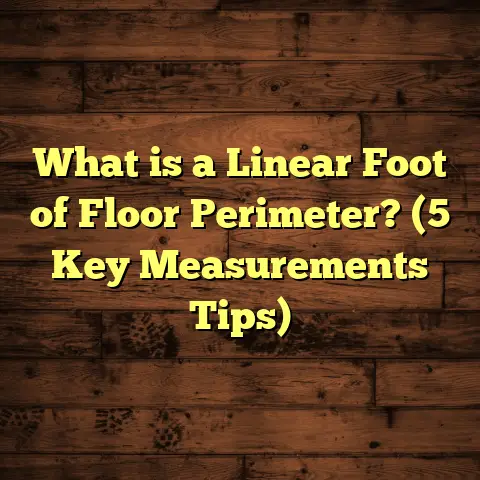What is Finished Floor to Subfloor? (5 Key Differences Explained)
Fast Solutions for Flooring Projects: Understanding Finished Floor to Subfloor
Have you ever been in a rush to get your floors done and then found yourself frustrated because things didn’t go as smoothly as planned? I know I have. Flooring projects can feel overwhelming when you don’t have a clear picture of what’s happening beneath your feet. When I first started working in this field, I often saw homeowners focus solely on the finish—the shiny hardwood or the trendy vinyl planks—only to ignore the base they were installed on. That’s where trouble begins.
I’m here to break it down for you: what exactly is the difference between the finished floor and the subfloor? Why does this matter? And how can understanding these layers save you time, money, and stress on your next flooring project?
What Is Finished Floor to Subfloor?
Here’s the simple definition:
- Finished Floor: This is the topmost layer of your flooring system that you actually see and walk on every day. It could be hardwood, tile, carpet, laminate, vinyl plank, or any other type of flooring. It serves both functional and decorative purposes—adding comfort, style, and durability.
- Subfloor: This is the layer underneath the finished floor. It’s a structural component made from sturdy materials like plywood or OSB (or concrete in some cases), which rests on top of the floor joists (the wooden beams supporting your floor). The subfloor acts like the foundation for your finished floor.
The subfloor provides the crucial support needed so your finished floor can perform well over time. Think of the subfloor as the solid ground beneath a stage, while the finished floor is the surface performers dance on.
Why Does This Difference Matter So Much?
I’ve seen many projects where homeowners or even contractors overlooked subfloor conditions. One memorable job was an elegant hardwood installation in a century-old home. The finished floor looked stunning at first, but after a few months, several boards began to buckle and pop up. When we lifted a section of flooring, we found that the subfloor was uneven and had moisture damage that wasn’t addressed before installation.
This kind of problem is all too common. No matter how beautiful or expensive your finished flooring is, if the subfloor isn’t properly prepared—level, stable, and dry—you’re setting yourself up for issues down the road.
5 Key Differences Between Finished Floor and Subfloor Explained
1. Purpose and Functionality
Let’s keep it simple: the subfloor supports everything above it. It bears the weight of furniture, people, pets, and more. It must be strong, stable, and flat to prevent movement that could damage your finished floor.
The finished floor’s job is quite different—it’s about comfort, safety, and visual appeal. It provides texture underfoot, protects against wear and tear, and styles your space.
Why is this important? Because sometimes people confuse strength with beauty and try to cut corners by skipping proper subfloor prep. You might end up with a gorgeous floor that cracks or squeaks because it’s sitting on weak ground.
My Advice:
Always treat your subfloor like the unsung hero of your flooring project. Take time to inspect and repair it before thinking about finishes.
2. Material Composition
Subfloors are typically made from:
- Plywood: This is layered wood sheets glued together for strength.
- Oriented Strand Board (OSB): Made from compressed wood strands; cheaper but less moisture-resistant than plywood.
- Concrete: Usually in basements or slab-on-grade foundations.
Each has pros and cons. For example, plywood tends to be more stable but costs more. OSB is budget-friendly but can swell with moisture.
Finished floors include:
- Hardwood: Solid or engineered.
- Laminate: A photographic layer over fiberboard.
- Tile: Ceramic or porcelain.
- Vinyl Plank: Durable and waterproof.
- Carpet: Soft and insulating.
Each material interacts differently with its subfloor. For example:
- Tile requires a very flat subfloor to avoid cracking.
- Hardwood needs a dry subfloor to prevent warping.
- Vinyl can be installed over concrete but needs moisture barriers.
3. Installation Process
Here’s how things usually go down on site:
- The subfloor is installed first. This involves laying sheets over joists, then securing them with nails or screws to keep things tight and prevent squeaks.
- Once the subfloor is ready—level, clean, and dry—the finished floor can go on top using methods suited for each material:
- Hardwood might be nailed or glued.
- Laminate usually “floats” with no attachment.
- Tile is set in mortar.
- Vinyl planks often have glue or click-lock systems.
Skipping steps or rushing subfloor prep causes trouble later. For instance, uneven subfloors cause tiles to crack or vinyl to bubble.
Real Example:
On a recent project installing laminate flooring in a rental unit, we discovered the subfloor was uneven by as much as 1/4 inch over 8 feet—a big no-no for laminate. We had to sand down high spots and fill low areas before proceeding. The extra work added two days but kept everything smooth and squeak-free later.
4. Impact on Comfort and Sound
Subfloors are hard and rigid; they don’t absorb sound or cushion footsteps much.
The finished floor plays a big role in how your room feels:
- Carpet softens sounds and cushions feet.
- Hardwood can be noisy without underlayment.
- Vinyl offers moderate cushioning.
- Tile is hard and echoes more.
Adding underlayment between subfloor and finish can reduce noise by up to 40% according to studies I’ve seen in multi-family buildings.
5. Maintenance Needs
Subfloors generally don’t require maintenance once installed properly but must be protected from moisture during construction.
Finished floors need ongoing care:
- Hardwood needs refinishing every 5–10 years depending on wear.
- Tile grout should be sealed every few years.
- Carpet benefits from regular professional cleaning.
Moisture management is key for both layers; water damage can ruin subfloors and finishes alike.
More Than Basics: Deep Insights From My Experience
How Flat Does Your Subfloor Really Need to Be?
Flatness standards vary by flooring type:
| Flooring Type | Maximum Allowed Deviation |
|---|---|
| Tile | 1/8 inch over 6 feet |
| Hardwood | 3/16 inch over 10 feet |
| Laminate | 3/16 inch over 10 feet |
| Vinyl Plank | 1/8 inch over 6 feet |
When I first started measuring flatness with laser levels and straightedges, I realized many older homes fail these standards by a wide margin—sometimes up to 3/8 inch deviations! That may not sound like much but can cause cracking or gaps in finished floors.
Moisture Content: The Silent Enemy
Wood products absorb moisture from air and spills, expanding or contracting as a result.
Here are some benchmarks I always use:
| Material | Maximum Moisture Content Allowed Before Installation |
|---|---|
| Plywood/Subfloor | ≤12% |
| Hardwood Floor | 6–9% |
| Engineered Wood | Up to 12% (depends on product) |
Ignoring these limits often leads to warping or cupping floors later. I’ve seen projects where moisture content was ignored due to tight timelines, resulting in floors buckling within weeks after installation.
Real Case Study: Old House Renovation
A client wanted to install hardwood in a historic home with original tongue-and-groove pine floors underneath instead of plywood subflooring. We tested moisture content (it was borderline at 14%) and flatness (off by 1/4 inch).
We recommended installing new plywood over the old boards after using a moisture barrier. This step took extra time and money but prevented major problems later when humidity fluctuated seasonally.
Soundproofing Insights
In apartments or condos, soundproofing matters greatly. Adding sound-reducing underlayment between subfloor and finished floor can reduce impact noise by about 30–40%.
I often recommend cork or rubber-based underlayments for hardwood or laminate floors in multi-story buildings.
Tips From My Toolbox
Tip #1: Use a Moisture Meter—Not Just Your Eyes
Never guess moisture content visually. A handheld meter costs under $50 but saves thousands in repairs.
Tip #2: Don’t Skimp on Subfloor Repairs
Loose boards? Cracks? Fill gaps with wood filler or replace damaged sections before installing finished flooring.
Tip #3: Choose Underlayment Wisely
Underlayment improves comfort and sound but also acts as a moisture barrier in some cases (especially under laminate).
Tip #4: Plan Expansion Gaps Carefully
Wood floors expand with humidity changes; leaving gaps prevents buckling—usually around 1/4 inch around perimeter walls.
Tip #5: Watch Out for Concrete Slabs
If installing over concrete slabs, test for moisture using calcium chloride tests or relative humidity probes before installation.
Adding Value With Finished Floors: Why It Pays Off
The right combination of finished floor and properly prepared subfloor not only looks better but also lasts longer—saving you money over time.
For example:
- A well-installed hardwood floor can increase home resale value by up to 2–3%.
- Properly laid tile reduces repair costs caused by cracking by nearly 75%.
Final Thoughts: What I’ve Learned Over the Years
Understanding the differences between finished floors and subfloors isn’t just technical jargon—it directly impacts your project’s success.
From personal experience:
- Rushing flooring installation without checking subfloor conditions almost always leads to problems.
- Spending time on prep might feel like an inconvenience but pays off massively.
- Moisture testing is non-negotiable for wood floors.
- Noise control matters more than people expect; consider soundproofing if you live above other people.
- Choosing quality materials for both layers ensures durability and comfort.
Whether you’re tackling a DIY project or hiring pros, ask questions about your subfloor condition before picking finishes.
If you want me to help you assess your current floor system or give personalized advice based on your home’s specifics, just reach out! Floors are literally what hold your life together—let’s get them right together.





